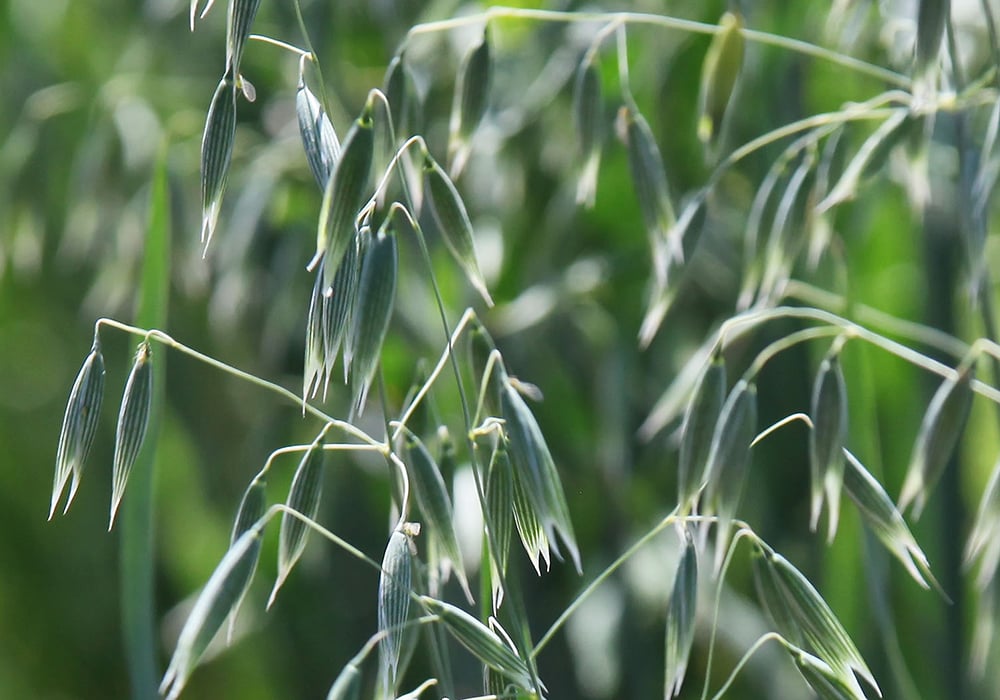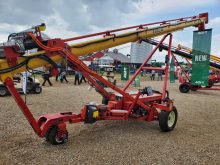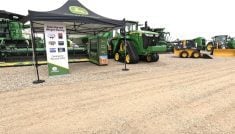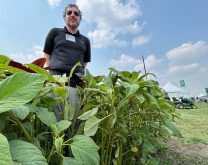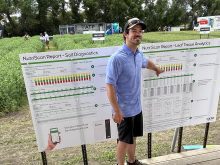Seed companies look to new varieties to get farmers excited about oats again
When this story ran in the New Seed Variety Guide it incorrectly identified FP Genetics.
Oats have had a tough time of late.
After reaching a 10-year high of 3.9 million acres in 2022, oat acres dove 40 per cent to 2.5 million acres the next year, the lowest number on record.
Read Also

Using artificial intelligence in agriculture starts with the right data
Good data is critical as the agriculture sector increasingly adopts new AI technology to drive efficiency, sustainability and trust across all levels of the value chain.
However, with some promising new varieties coming down the pipe, seed companies are hoping their new offerings will get farmers to start thinking about oats again. Several of those new varieties were on display at the Ag in Motion farm show in Langham, Saskatchewan, in July.
Other stories in the New Seed Variety Guide 2025:
- What crop traits are on your wish list?
- Early maturing soybeans
- Phenotyping a la carte
- Durum variety designed for higher food fibre
- Genetic modification, global trade and illegal seed concern seed growers
SeCan
Boost is the latest feed and forage oat from SeCan.
“It’s a new style of forage oat,” said Todd Hyra, western business manager for SeCan. “It has later maturity and is an upright plant type.”
Compared to CDC Haymaker, SeCan’s go-to feed and forage oat for the last 12 years, Boost has some properties that many growers may find appealing.
On the forage side of things, Haymaker is still top dog. However, in terms of feed, Boost surpasses its predecessor.
“If you look at the leaves on Haymaker, which is what attracted people to this variety from the beginning, it has these massive leaves and high biomass,” said Hyra. “Boost is sort of a new style; not quite as big of leaves, but more stems and more upright growth.”

He points out that growing Haymaker with a companion species could be problematic for farmers.
“They would be shadowing out and choking out some of the companion species,” said Hyra. “Whereas Boost is more of an open canopy and allows both to thrive.”
In terms of milling oats, AAC Douglas, a white-hulled milling oat with improved yield, strong straw and high beta-glucan, has recently been approved for milling.
“It’s got all the thumbs up and the green lights,” said Hyra.
AAC Neville and AAC Anthony are next in line, but they’re still in the process of getting miller approvals.
“AAC, Anthony, it is in process right now. So we’ve got one year of data on it,” said Hyra. “For AAC Neville, this year will see its first harvest, and the first chance the mills will get to look at it to see if it will work.”
Hyra said the two varieties are available for 2025, but they haven’t received full endorsement from the millers.
“That’s the missing piece,” he said.
FP Genetics
FP Genetics has a new forage/feed oat called CDC West Gate that the company’s Manitoba rep, Chad Yanchycki, said shows excellent promise.
“It’s a really tall, thick, bushy plant, with nice, big flag leaves on it, lots of material there,” he said.
Yanchycki said FP’s seed growers are pleased with the new variety and are seeing 106 per cent of forage yield and 114 per cent of grain yield when compared to some of the market leaders forage oats. It also drew a lot of attention at AIM.
“The farmers who have been able to walk through some of the plot sites are excited about the size of the plant, the thickness of the stems and leaves, and the grain yield it provides,” said Yanchycki. “I think it’s going to be an exciting one to watch.”
But he’s even more excited about FP Genetics’ latest milling variety that will become available in 2025.
“This is probably one of the most exciting oat varieties to hit the market in years,” said Yanchycki. “I’ve never had more commercial growers call me, asking questions about the variety, trying to get access and see how soon they can buy it.”
The biggest reason for this is the exceptional yield that Anson promises.
“It was a top yielder last year for anybody that got to grow it from our seed grower network,” said Yanchycki.
It’s also a very short variety compared to other milling oats that have come out in recent years.
“Anson is coming anywhere from eight to 14 inches shorter in height than some of those industry-leading varieties,” he said. “So the growers are extremely excited to have a new milling oat that not only yields extremely high, but it’s got a really short height to it and a little bit less straw to it.”
FP Genetics is currently in the process of obtaining approval from the major millers for this project in the fall and winter, in preparation for the anticipated launch next year.
Canterra Seeds
Canterra Seeds was showing off some of their latest milling varieties at AIM.
“These are variety names that farmers probably won’t recognize because they haven’t seen them yet,” said Canterra’s pedigreed seed business manager, Rick Love.
Love sees these new varieties as a potential replacement for CS Camden.
“CS Camden is the most widely grown milling oat in Western Canada. But it’s had its time where it’s now in a little bit of decline as newer varieties displace it,” said Love. “So we’re trying to find a replacement as well.”
The two varieties that Canterra spotlighted at AIM come from the same breeding program that developed CS Camden (Lantmännen). They’re called Kalio and Kyron.
The varieties are registered for sale in Canada, but Canterra is still working on obtaining milling acceptance. Kalio has been added to the preferred milling oat varieties with Richardson milling, and Kyron received its first acceptance from grain millers in Yorkton.
“We’re in limited launch of both the varieties right now. So we hope to grow the availability across Western Canada,” said Love. “Kyron is available in East Central Saskatchewan and in the Peace River region, and Kalio’s availability is limited to the Red River Valley.”
While Canterra is focusing on milling varieties, Love said that doesn’t mean they’re not suitable for other purposes.
“The varieties that Lantmännen has been moving forward with have good biomass,” said Love. “Typically, their material has a lot of leaf material. So we would say that these are dual-purpose, but they are definitely not what we would call a forage oat.”


